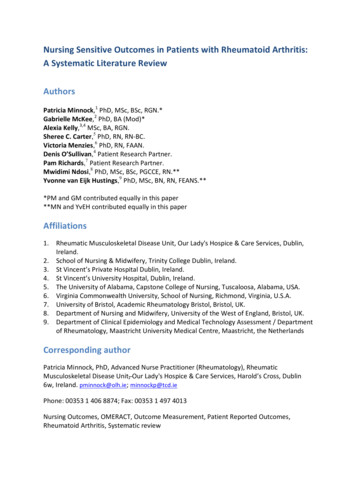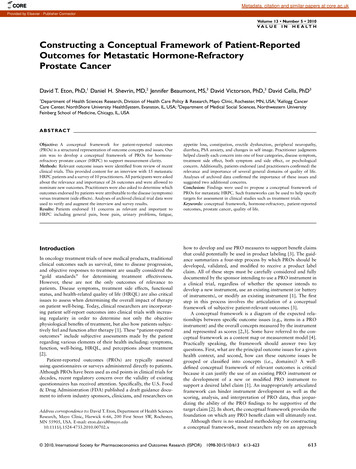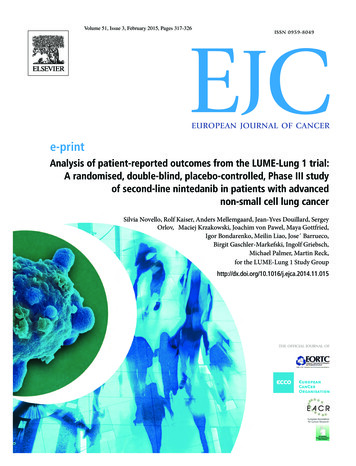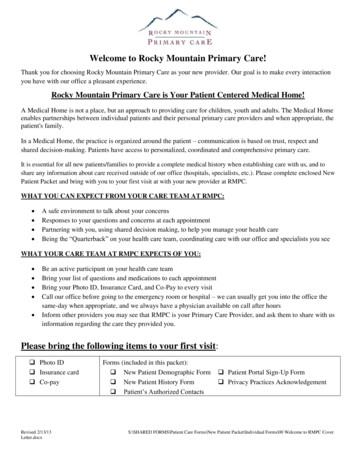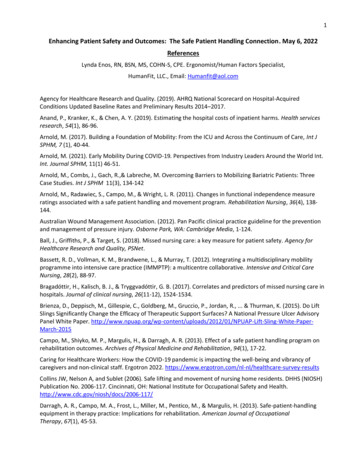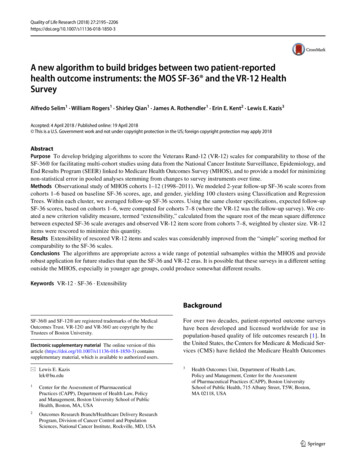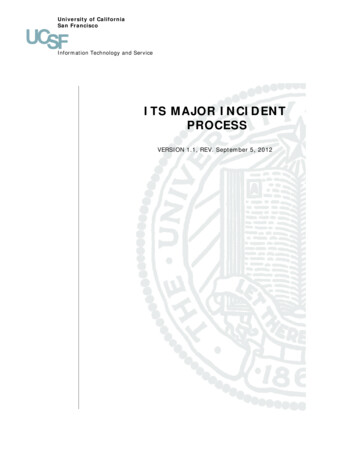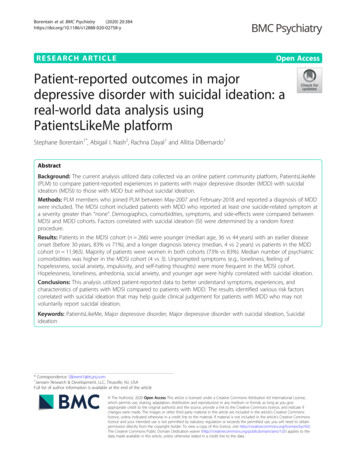
Transcription
Borentain et al. BMC Psychiatry(2020) SEARCH ARTICLEOpen AccessPatient-reported outcomes in majordepressive disorder with suicidal ideation: areal-world data analysis usingPatientsLikeMe platformStephane Borentain1*, Abigail I. Nash2, Rachna Dayal1 and Allitia DiBernardo1AbstractBackground: The current analysis utilized data collected via an online patient community platform, PatientsLikeMe(PLM) to compare patient-reported experiences in patients with major depressive disorder (MDD) with suicidalideation (MDSI) to those with MDD but without suicidal ideation.Methods: PLM members who joined PLM between May-2007 and February-2018 and reported a diagnosis of MDDwere included. The MDSI cohort included patients with MDD who reported at least one suicide-related symptom ata severity greater than “none”. Demographics, comorbidities, symptoms, and side-effects were compared betweenMDSI and MDD cohorts. Factors correlated with suicidal ideation (SI) were determined by a random forestprocedure.Results: Patients in the MDSI cohort (n 266) were younger (median age, 36 vs 44 years) with an earlier diseaseonset (before 30 years, 83% vs 71%), and a longer diagnosis latency (median, 4 vs 2 years) vs patients in the MDDcohort (n 11,963). Majority of patients were women in both cohorts (73% vs 83%). Median number of psychiatriccomorbidities was higher in the MDSI cohort (4 vs 3). Unprompted symptoms (e.g., loneliness, feeling ofhopelessness, social anxiety, impulsivity, and self-hating thoughts) were more frequent in the MDSI cohort.Hopelessness, loneliness, anhedonia, social anxiety, and younger age were highly correlated with suicidal ideation.Conclusions: This analysis utilized patient-reported data to better understand symptoms, experiences, andcharacteristics of patients with MDSI compared to patients with MDD. The results identified various risk factorscorrelated with suicidal ideation that may help guide clinical judgement for patients with MDD who may notvoluntarily report suicidal ideation.Keywords: PatientsLikeMe, Major depressive disorder, Major depressive disorder with suicidal ideation, Suicidalideation* Correspondence: SBorent1@its.jnj.com1Janssen Research & Development, LLC, Titusville, NJ, USAFull list of author information is available at the end of the article The Author(s). 2020 Open Access This article is licensed under a Creative Commons Attribution 4.0 International License,which permits use, sharing, adaptation, distribution and reproduction in any medium or format, as long as you giveappropriate credit to the original author(s) and the source, provide a link to the Creative Commons licence, and indicate ifchanges were made. The images or other third party material in this article are included in the article's Creative Commonslicence, unless indicated otherwise in a credit line to the material. If material is not included in the article's Creative Commonslicence and your intended use is not permitted by statutory regulation or exceeds the permitted use, you will need to obtainpermission directly from the copyright holder. To view a copy of this licence, visit http://creativecommons.org/licenses/by/4.0/.The Creative Commons Public Domain Dedication waiver ) applies to thedata made available in this article, unless otherwise stated in a credit line to the data.
Borentain et al. BMC Psychiatry(2020) 20:384BackgroundSuicide is a major public health concern and is one ofthe leading causes of death worldwide [1]. In the U.S.,47,000 deaths were reported in 2017 due to suicide. Ofthe 17.6 million patients with major depressive disorder(MDD), 5.5 million adults reported suicide ideation (SI)and 2 million patients reported SI with intent [2]. In thesame year, age adjusted suicide rate was 15.3 per 100,000 persons, considerably higher than the global rate of10.5 per 100,000 persons [3, 4]. Notably, the highestprevalence of suicide is found in the most economicallyproductive age group (15–44 years) [5]. Moreover, examination of data of young adults aged 18–25 years fromthe National Surveys on Drug Use and Health (2009–2015) showed an increase in the 12-month prevalence ofSI (6.1 to 8.3%), suicide plan (2.0 to 2.7%), and suicideattempt (1.1 to 1.6%) [6].Suicidal behavior and ideation have a significant economic burden. In Europe, Jaffe et al. [7] reported SI tobe associated with higher absenteeism, presenteeism,work productivity impairment, and activity impairmentcompared to individuals without SI. The burden of suicidal behavior and ideation extends to caregivers of individuals with SI, as they reported that the constant worryaffected their social and occupational functioning [8]. Inaddition to the traumatic, often unexpected loss of life,friends and family members of an individual who dies bysuicide may face social isolation, stigma, and are at increased risk for depression-related mental illness, substance abuse, and suicide [9].MDD is the mental health diagnosis most commonly associated with suicide. Globally, more than 60% of individuals who have attempted suicide struggle with MDD [10].Moreover, patients with MDD have a 20-fold higher riskof suicide than the general population [11]. As the prevalence of SI is high among patients with MDD, understanding the characteristics that differ in patients with MDDand SI compared to those without SI is critical for earlyidentification of high-risk patients [12].Detection of SI, early diagnosis of depression, continuity of care and treatment adherence have been identifiedas critical to improve outcomes in patient with SI [13].Therefore, it is important to understand the patientperspective and the needs of this high-risk population toincrease efficacy of suicide prevention strategies. Comorbid psychiatric conditions such as personality disorders,anxiety disorders, and substance use disorders are associated with an increased risk of suicide in patients withMDD [14–17]. Hence, the treatment plan should alsofeature concomitant treatment of the comorbid condition. In patients with comorbid substance use disorders,easing access to treatment, providing counseling, and social support in addition to the treatment of depression isrecommended [15]. However, as patients with SI arePage 2 of 11often excluded from most antidepressant trials, limiteddata are available to study their disease or treatmentcharacteristics [18].Online patient communities provide patients with aplatform to share their disease and treatment experiences, which subsequently provide researchers withvaluable data pertaining to patient reported outcomes,perspectives, and preferences [19]. PatientsLikeMe(PLM) is one such global online community that provides patients with resources to record, track, and sharetheir symptoms, disease experiences, and treatment outcomes, and to improve their care through peer-to-peerinteractions. Patients are free to share as much or as little data as they want. PLM enables visualization of an individual’s health profile graphically as well as aggregatesdata into reports that are available on the website [20].The PLM community comprises 775,000 patients overall from across the globe, with 62,100 members reporting a diagnosis of MDD (as of 23rd May 2020) [21]. Inthe present analysis, we utilized the data provided byPLM to characterize and compare the patient-reportedcharacteristics and experiences of living with MDD withSI (MDSI group) to those with MDD but without SI(MDD group).MethodsStudy populationRetrospective data of adult patients (aged 18 years) whowere members of the global PLM community, registeredto the PLM website between May 2007 and February2018, and reported a diagnosis of MDD were obtained.Although patients in the PLM community were notprompted to report any symptom related to SI, those patients who reported at least one SI-related symptom(“suicidal thoughts or urges,” “suicidal,” “depression withsuicidal thoughts,” “SI,” “suicide attempt,” or “suicidalbehavior”) at a severity greater than none were includedin the MDSI cohort. Patients who reported an MDDdiagnosis without any suicide-related symptoms wereincluded in the MDD cohort. Patients who reported aprimary diagnosis of bipolar disorder, borderline personality disorder, paranoid schizophrenia, Parkinson’sdisease, post-traumatic stress disorder, psychosis disorder, psychotic depression, schizoaffective disorder,schizoid personality disorder, schizophrenia, or any lifethreatening illness (e,g., cancer) in the PLM databasewere excluded (Supplementary Table 1). Patients withactive or prior history of substance abuse/dependencewere not excluded.AssessmentsAll assessments were performed based on the clinical,diagnostic, and treatment experiences reported by patients with MDD (with and without SI) on the PLM
Borentain et al. BMC Psychiatry(2020) 20:384platform. Direct, spontaneous data reported by the patients were used and no validated instruments wereemployed for data collection. The data collected frompatients were categorized into demographics, comorbidconditions, symptoms, and treatments. Demographicdata of patients included age, sex, race/ethnicity, nationality, education level, and health insurance type, whilecomorbidities and condition-associated information included diagnosis status, onset date (date of first symptom), and diagnosis date. The prevalence of eachcomorbidity was also assessed.Symptoms reported by the patients on the PLM platform were categorized into three groups: prompted general symptoms (pain, fatigue, insomnia, depressed mood,and anxious mood), MDD-specific symptoms (increasedneed for sleep, anhedonia, decreased/increased appetite,irritability, bradykinesia, and decreased sex drive), andspontaneously-reported symptoms (any symptom thepatient wishes to report and track on their profile). Recording the severity of the five general symptoms wasmandatory for patients with MDD on the PLM platformand severity reporting was also mandated for any MDDspecific or spontaneously reported symptoms the patientchose to include. Symptom severity was recorded on asubjective rating scale, by the patient, as none, mild,moderate, and severe.All patients on the PLM platform who reported anMDD diagnosis were prompted to report whether theyhave ever been prescribed any of the following MDDassociated treatments: bupropion, citalopram, duloxetine, escitalopram, fluoxetine, sertraline, venlafaxine orindividual therapy. Additionally, patients also providedtreatment related details including treatment dose, startdate, perceived effectiveness, side effects and their severity, and burden of treatment. Perceived treatment effectiveness was recorded on a subjective rating scale, by thepatient, as “can’t tell,” “none,” “slight,” “moderate,” and“major,” while severity of side effects was rated as “none,” “mild,” “moderate,” and “severe.”Patients were also encouraged to complete a moodmap platform survey (PLM’s proprietary 25-item survey,which captured information that might reflect the patient’s current mood) as well as freely enter text in forums, treatment evaluation reports, and treatment stopreports.Risk factors for suicidal ideationWe used a random forest classifier (RF) to determinethe risk factors for SI in the study population. A RF is adata classification algorithm comprising multiple individual decision trees that operate as a group or ensemble. Each tree gives a class or variable prediction and theone with the most votes becomes the model’s prediction[22]. RF has advantages over other data classificationPage 3 of 11methodologies such as the ability to handle highly nonlinearly correlated data, robustness to noise, tuning simplicity, and opportunity for efficient parallel processing[23]. We developed and trained the RF model to predictwhether a patient belongs to the MDSI cohort or MDDcohort. Demographic, comorbidity, symptom, and moodmap variables were assessed to determine the most important characteristics in distinguishing the cohorts.Statistical analysisDescriptive statistics were used to summarize the data.Categorical variables were presented as frequency andnumbers while continuous variables were presented asmedians.A chi-square test of independence was applied to compare sets of distributions, whereas a binomial test of proportions was used for pairwise comparison of binaryproportions. Bonferroni correction was applied to control for potential Type I errors related to multiple comparisons. Variability around proportions was presentedby 95% confidence intervals (CI). CIs of binary proportions were calculated using Clopper-Pearson method,which yields asymmetric upper and lower bounds thatdo not exceed 0 or 1.ResultsPatient characteristicsOf the 12,229 PLM users with MDD who registered andprovided data during the study period, 266 reportedsymptoms related to suicidality with a severity greaterthan none (MDSI cohort), and 11,963 reported never experiencing any of these symptoms (MDD cohort).The majority of the patients in both cohorts wereWhite (MDSI: 87.5% vs. MDD: 86.7%, p 0.3158) andhad completed at least high school (MDSI: 91% vs.MDD: 94%, p 0.3606). Patients in the MDSI cohortcompared to those in the MDD cohort were significantlyyounger (median age 36 years vs. 44 years, p 0.0001),more frequently men (27.1% vs. 16.7%, p 0.0001), andwere less likely to report a family history of MDD (45.9%vs. 49.7%, p 0.0003) (Table 1).Condition reportsOnset date and diagnosis latencyA total of 129 (48.5%) patients in the MDSI cohortand 6440 (53.8%) patients in the MDD cohort reported their first symptom date, while the diagnosisdate was reported by 121 (46.0%) and 5943 (49.7%)patients in the MDSI and MDD cohorts, respectively.The MDSI cohort included a significantly larger proportion of users reporting an age of onset 30 years(83.0% vs. 71.2%, p 0.001) and significantly longermedian diagnosis latency compared to the MDD cohort (4 years vs. 2 years, p 0.0002).
Borentain et al. BMC Psychiatry(2020) 20:384Page 4 of 11Table 1 Baseline characteristicsVariableMDSI (n 266)MDD (n 11,963)258 (96.9)11,553 (96.6)Gender, n (%)TotalWomen188 (72.9)9622 (83.3)Men70 (27.1)1931 (16.7)252 (94.7)11,486 (96.0)3644Age, yearsTotalMedianRace, n (%)Total136 (51.1)8.970 (74.9)White119 (87.5)7781 (86.7)Mixed race8 (5.9)372 (4.1)Black/African American2 (1.5)263 (2.9)American Indian/Alaskan native1 (0.7)98 (1.1)Asian4 (2.9)113 (1.25)Native Hawaiian/other Pacific Islander0 (0)14 (0.2)Preferred not to disclose2 (1.47)329 (3.7)129 (48.5)7510 (62.8)8th grade or less (left school around 14 years of age)035 (0.5)Some high school, but did not graduate (left school around 16 years of age)9 (7.0)270 (3.6)Education, n (%)TotalHigh school graduate or GED (left school around 18 years of age)23 (17.8)1161 (15.5)Some college but less than a bachelor’s/undergraduate degree51 (39.5)3273 (43.6)College bachelor’s/undergraduate degree24 (18.6)1650 (22.0)Postgraduate degree (Master’s, doctorate, etc.)19 (14.7)952 (12.7)Preferred not to answer3 (2.3)169 (2.3)Family history of MDD, n (%)Total218 (82.0)6752 (56.4)Yes100 (45.9)3353 (49.7)No92 (42.2)2075 (30.7)Don’t know26 (11.9)1324 (19.6)Abbreviations: GED General Education Development, MDD Major Depressive Disorder, MDSI Major Depressive Disorder with Suicidal IdeationComorbiditiesA total of 229 (86.1%) patients in the MDSI cohort and8054 (67.3%) patients in the MDD cohort reported dataon at least one comorbidity. The MDSI cohort reporteda significantly greater median number of comorbiditiesthan the MDD cohort (4 vs. 3, p 0.0001). The top threecomorbidities reported at a higher frequency in theMDSI cohort compared to the MDD cohort were generalized anxiety disorder (63.1%; 95% CI, 56.7–69.6% vs.44.3%; 95% CI, 43.3–45.5%), social anxiety disorder(44.5%; 95% CI, 38.0–51.2% vs. 18.3%; 95% CI, 17.4–19.1%), and dysthymia (35.4%; 95% CI, 29.2–41.9% vs17.7%; 95% CI, 16.9–18.6%) (p 0.001 for all). However,the proportion of these comorbid conditions was relatively high in MDD cohort as well. Fibromyalgia was theonly comorbidity that was reported significantly more inthe MDD cohort than the MDSI cohort (31.0%; 95% CI,30.0–32.0% vs. 9.6%; 95% CI, 6.1–14.2%, p 0.001)(Fig. 1).Symptom reportsAll patients (MDSI: 266, MDD: 11,963) included in thestudy reported at least one symptom. Pain was the onlyprompted symptom that showed a significant differencein reporting frequency after averaging patient reportsover time (MDSI: 43.2%; 95% CI, 35.0–51.6% vs. MDD:58.9%; 95% CI, 57.9–59.9%, p 0.001) (Fig. 2a). However,comparison of worst-ever scoring for prompted symptoms showed a significantly greater reporting frequencyof “high severity” in the MDSI cohort than the MDD
Borentain et al. BMC Psychiatry(2020) 20:384Page 5 of 11Fig. 1 Top comorbiditiesFig. 2 Median and worst scores of top symptoms reported. (a) Median scores of top prompted symptoms reported (b) Worst scores of topprompted symptoms reported (c) Median scores of MDD-specific symptoms (d) Worst scores of MDD-specific symptoms
Borentain et al. BMC Psychiatry(2020) 20:384cohort for anxious mood (88.8%; 95% CI, 83.6–92.9% vs.70.6%; 95% CI, 69.7–71.5%, p 0.0001), depressed mood(94.4%; 95% CI, 90.3–97.2% vs. 78.0%; 95% CI, 77.1–78.8%, p 0.0001), and fatigue (89.5; 95% CI, 84.5–93.3%vs. 81.6%; 95% CI, 80.8–82.3%, p 0.01) (Fig. 2b).No significant differences were observed between thetwo groups in the reporting frequency of MDD-specificsymptoms after averaging patient reports over time (Fig.2c). However, when the worst-ever scores were considered, significantly greater reporting frequency of “highseverity” was observed in the MDSI cohort compared tothe MDD cohort for anhedonia (76.9%; 95% CI, 69.2–83.6% vs. 54.6%; 95% CI, 53.5–55.7%, p 0.0001) and irritability (84.0%; 95% CI, 75.0–90.8% vs. 67.8%; 95% CI,65.2–70.3%, p 0.001) (Fig. 2d). The prompted andMDD-specific symptoms’ results are supported by themood map analysis. While symptom severities betweenthe cohorts are similar when averaged over time(Supplementary Figure 1A), certain symptoms includingdepressed or anxious mood and irritability, do increasein severity when patients are at their worst (Supplementary Figure 1B).Spontaneous symptom reporting frequency was significantly greater in the MDSI cohort compared to theMDD cohort for symptoms including panic attack(27.1%; 95% CI, 21.8–32.8% vs. 7.5%; 95% CI, 7.0–8.0%),Fig. 3 Top reported unprompted symptomsPage 6 of 11restlessness (26.6%; 95% CI, 20.4–31.3% vs. 12.3%; 95%CI, 11.7–12.9%), memory problems (25.2%; 95% CI,20.1–30.9% vs. 6.3%; 95% CI, 5.8–6.7%), loneliness(24.1%; 95% CI, 19.1–29.7% vs. 1.1%; 95% CI, 0.96–1.34%, p 0.0001 for all), and persistent worry (24.1%;95% CI, 19.1–29.7% vs. 12.3%; 95% CI, 11.8–12.9%,p 0.001) (Fig. 3).Treatment reportsA total of 243 (91.4%) patients in the MDSI cohort and10,951 (91.5%) patients in the MDD cohort reportedreceiving 1 treatment during the observational period.The MDSI cohort reported intake of more antidepressant treatments than the MDD cohort (mean values: 3vs. 2.4). The five most reported treatments weresertraline (36.6%), bupropion (36.6%), fluoxetine (35.8%),venlafaxine (32.9%), and citalopram (31.3%) in the MDSIcohort, and bupropion (38.3%), fluoxetine (34.2%),sertraline (33.4%), duloxetine (32.0%), and venlafaxine(30.9%) in the MDD cohort.Treatment’s perceived effectivenessThe proportion of patients who reported “moderate tomajor perceived effectiveness” with commonly prescribed antidepressant treatments was higher in theMDD cohort compared with the MDSI cohort. The
Borentain et al. BMC Psychiatry(2020) 20:384MDSI cohort experienced the lowest perceived effectiveness for citalopram (25.0% vs. 52.0%), venlafaxine (35.0%vs. 66.0%), and duloxetine (40.0% vs. 60.0%) (Fig. 4a).Treatment burden and side-effectsA total of 134 (50.4%) patients in the MDSI cohort and3070 (25.7%) patients in the MDD cohort reported datafor treatment burden and side-effects. Patients in theMDSI cohort more frequently reported side-effects withduloxetine (78.0% vs. 37.0%), citalopram (52.0% vs30.0%), and bupropion (36.0% vs. 25.0%) compared tothose in the MDD cohort. Similar trends were observedfor side effects with other treatments (Fig. 4b).The proportion of patients rating antidepressant treatments as “somewhat to very” burdensome was greater inthe MDSI cohort compared to the MDD cohort for sertraline (14.0% vs. 10.0%), venlafaxine (24.0% vs. 14.0%),citalopram (20.0% vs. 12.0%), and duloxetine (22.0% vs.12.0%); but lesser compared to the MDD cohort for bupropion (8.0% vs. 9.0%), fluoxetine (0% vs. 11.0%), andescitalopram (8.0% vs. 12.0%).Risk factors for suicidal ideationA RF classifier determined the risk factors for SI bypredicting whether a patient belonged to the MDSI orMDD cohort. Each variable or feature was assigned animportance value to determine ranking. Variables include demographic characteristics, comorbidities,prompted and unprompted symptoms, and mood mapitems. Supplementary Figure 2 shows the receiver operating characteristic curve of the RF model. According tothe feature importance values obtained from the classifier, feelings of hopelessness (importance value: 0.09[standard deviation: 0.04]), loneliness (0.08 [0.04]), anhedonia (0.06 [0.04]), social anxiety (0.05 [0.03]) and age(0.04 [0.01]) were the top five predictors of SI in patientsdiagnosed with MDD in the PLM platform (Fig. 5).Page 7 of 11DiscussionRetrospective analysis of patient-reported data from thePLM depression community showed patients with MDSIare younger, have more comorbidities and higher symptom severity, and experience lower treatment effectiveness but higher treatment side effects.Among patients with MDD, our results indicated agreater proportion of SI among young adults, with almost 50% of the MDSI cohort being below 35 years ofage; as well as among males and patients with a familyhistory of MDD. These findings are consistent with earlier reports and WHO-provided suicide rate data for theUS [3, 6, 24]. Han et al. [6] evaluated data of youngadults aged 18–25 years from the National Surveys onDrug Use and Health (2009–2015) and reported themean 2009–2015 annual prevalence of SI among patients with a major depressive episode (MDE) in the USto be 37.3%. Prevalence of SI differs depending on thetype of reporting method used. The higher prevalence ofSI among 18–25 year old patients in the Han et al. study[6] (37.3%) compared to the MDSI cohort of the presentstudy (28.2%) is probably driven by the difference inreporting method (prompted national survey vs. voluntary web-based platform). In the present study, reportingof SI was anonymous, but patients were not promptedto report any SI-related symptom. Other factors influencing the difference in prevalence of SI could be the larger sample size (n 145,800 vs. n 12,229), agedifference (only young adults [18–25 years] vs. all agegroups [median age 36 years]), and confirmation of depression (MDE based on DSM-IV vs. self-reported diagnosis of MDD). In line with previous surveys [6, 25–27],the present study reported a greater proportion ofwomen reporting diagnosis of MDD than men regardlessof presence of SI.The greater proportion of young adults in the MDSIcohort was associated with reduced age of onset fordepression in this cohort compared to the MDD cohortFig. 4 Perceived treatment effectiveness, and treatment side-effects in MDSI and MDD cohorts (a) Perceived treatment effectiveness (b)Side effects
Borentain et al. BMC Psychiatry(2020) 20:384Page 8 of 11Fig. 5 Key risk factors for suicidal ideation in an MDD population( 20 years of age, 72.1% vs. 49.1%). Previous studieshave also associated SI with a young age of onset for depression [28–32]. Patients with MDD may be exposed toa greater risk of SI if they do not receive early treatmentfor MDD [33]. Studies have shown that longer durationof untreated MDD is a critical risk factor for SI in patients. Hence, early screening, diagnosis, and treatmentof MDD may contribute to reducing the risk of SI [34].A novel finding of the current study is that patients inthe MDSI cohort reported longer median diagnosis latency than the MDD cohort (4 vs. 2 years), which couldbe attributed to the lack of mental healthcare-seekingpattern in patients with SI [35, 36] leading to delays indiagnosis and treatment initiation.In the current study, 68% of the patients reported atleast one comorbidity, with the MDSI cohort reportingmore comorbidities than the MDD cohort. Additionally,patients with MDSI experienced more comorbid anxietyand substance use disorders than the MDD cohort.These findings were consistent with previous researchshowing a positive association between number of comorbidities and SI [26, 37, 38]. Furthermore, anxiety andsubstance use disorder were found to be independentrisk factors for suicide and pose a higher risk of suicideattempts [17, 26, 39–41].Previous research has shown a robust association between depression symptom severity and SI. Two different studies assessed outpatient data employing differentmethodologies and reported a significant relationshipbetween baseline depression severity and SI [31, 42]. Weevaluated symptoms using a three-pronged approach(prompted, MDD-specific, and spontaneous) to enablecomprehensive assessment in a standardized mannerand obtained similar results. The MDSI cohort exhibitedgreater prompted and MDD-specific symptom severity(anxious or depressed mood, anhedonia, and irritability),as well as spontaneous patient-reported symptoms pertaining to social isolation, hopelessness, and self-hatingthoughts compared to the MDD cohort. These symptoms have been associated with SI previously [31]. However, the symptom severity in the MDSI cohort wasgreater only at their worst, and not when averaged overtime. This unique finding may highlight a specific pattern of symptom evolution in patients with SI. In combination with treatment of depression; patients with SImay require regular tracking of symptom severity; atherapeutic strategy to reduce symptoms at their peakincluding emotion regulation psychotherapy; and easyaccess to crisis intervention units when the mitigationstrategies fail to control SI. Assessment of depressionseverity and treatment efficacy in patients with SIneeds to focus not only on the average severity butalso on the symptom’s maximum severity. Use ofdigital assessment tools would help patients to reportand collect symptoms’ severity data at their peak.However, currently available apps often lack clinicalreliability requirements [43].A greater number of patients in the MDSI cohort experienced severe side effects, lower antidepressant effectiveness, and greater burden from antidepressant usecompared to the MDD cohort. The aforementioned outcomes may be interlinked and affect each other. The lowperceived treatment effectiveness in the MDSI cohortmay be correlated with increased side effect severity;however, such associations were not evaluated. Althoughpatients with MDD and SI require consistent treatmentengagement to tackle the complex neuropsychologicalinterplay at hand, their needs to achieve this goal are
Borentain et al. BMC Psychiatry(2020) 20:384often unmet due to multiple factors including low adherence to treatment and follow-up [44]. Hence, understanding the patient’s perspective and expectation abouttreatment is critical to increase patient involvement andcontinuity of care.The present study identified young age and feelings ofhopelessness, loneliness, anhedonia, and social anxiety tobe significantly associated with SI in patients diagnosedwith MDD. These risk factors are consistent with previous studies across geographies that employed varyingmethodologies [27, 45–49]. This result also ties in withthe current study’s mood map analysis, which demonstrated increased symptom severity in the MDSI cohortcompared to the MDD cohort only during their worsesymptom report. Current research continues to look forpredictors of suicidal behavior such as biologicalmarkers, psychosocial factors and disease characteristicsamongst others to improve screening and identificationof patients at risk for suicidal behavior. Patient-reportedexperiences, such as what is available through PLM,allow us to examine associations between various patientcharacteristics with suicidal behavior from the perspective of the patient. As such, they provide additional datacompared to clinician-reported outcomes and add thespontaneously reported patient perspective.The concept of using online platforms and apps designed for patients with MDD to track their mood hasbeen reported previously [50]. Online communities suchas PLM can provide a safe space for individuals whomight not receive the support they require from friends,family, and healthcare providers. Moreover, these platforms provide tools to encourage patients to be activeand involved in their disease management, thus givingthem a sense of control. These benefits have been documented in patients with epilepsy [51, 52]. Sharing symptom and side effect-related information on suchplatforms may also help in informed decision-making,further benefitting the patient via improved outcomes.Finally, data collected through an online platform provides researchers a different set of information, collectedeither prospectively or retrospectively, and offers directaccess to the patients’ perspective.The stress-diathesis model acknowledges that suicidalideation and behavior is the result of a complex patternof biological and psychological risk factors combinedwith personal experiences and stressors. The currentstudy showed patients with MDD and SI struggle withmore comorbidities and have a different perception oftreatment effectiveness and burden. These factors require a tailored approach that may increase adherenceto treatment. Critical strategies to improve outcom
The PLM community comprises 775,000 patients over-all from across the globe, with 62,100 members report-ing a diagnosis of MDD (as of 23rd May 2020) [21]. In the present analysis, we utilized the data provided by PLM to characterize and compare the patient-reported characteristics and experiences of living with MDD with

